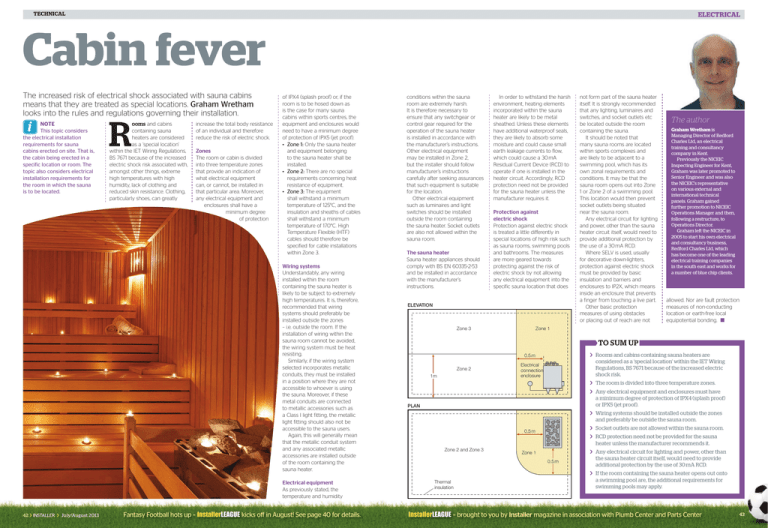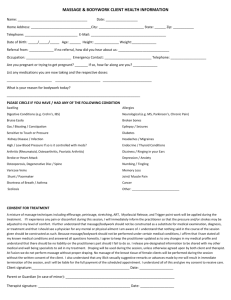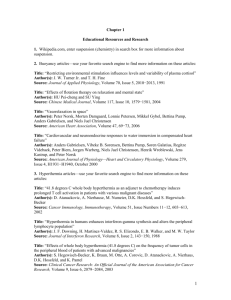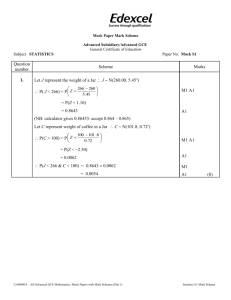The increased risk of electrical shock associated with sauna cabins
advertisement

ELECTRICAL TECHNICAL Cabin fever The increased risk of electrical shock associated with sauna cabins means that they are treated as special locations. Graham Wretham looks into the rules and regulations governing their installation. i NOTE This topic considers the electrical installation requirements for sauna cabins erected on site. That is, the cabin being erected in a specific location or room. The topic also considers electrical installation requirements for the room in which the sauna is to be located. R ooms and cabins containing sauna heaters are considered as a ‘special location’ within the IET Wiring Regulations, BS 7671 because of the increased electric shock risk associated with, amongst other things, extreme high temperatures with high humidity, lack of clothing and reduced skin resistance. Clothing, particularly shoes, can greatly increase the total body resistance of an individual and therefore reduce the risk of electric shock. Zones The room or cabin is divided into three temperature zones that provide an indication of what electrical equipment can, or cannot, be installed in that particular area. Moreover, any electrical equipment and enclosures shall have a minimum degree of protection of IPX4 (splash proof) or, if the room is to be hosed down as is the case for many sauna cabins within sports centres, the equipment and enclosures would need to have a minimum degree of protection of IPX5 (jet proof). • Zone 1: Only the sauna heater and equipment belonging to the sauna heater shall be installed. • Zone 2: There are no special requirements concerning heat resistance of equipment. • Zone 3: The equipment shall withstand a minimum temperature of 125°C, and the insulation and sheaths of cables shall withstand a minimum temperature of 170°C. High Temperature Flexible (HTF) cables should therefore be specified for cable installations within Zone 3. Wiring systems Understandably, any wiring installed within the room containing the sauna heater is likely to be subject to extremely high temperatures. It is, therefore, recommended that wiring systems should preferably be installed outside the zones – i.e. outside the room. If the installation of wiring within the sauna room cannot be avoided, the wiring system must be heat resisting. Similarly, if the wiring system selected incorporates metallic conduits, they must be installed in a position where they are not accessible to whoever is using the sauna. Moreover, if these metal conduits are connected to metallic accessories such as a Class I light fitting, the metallic light fitting should also not be accessible to the sauna users. Again, this will generally mean that the metallic conduit system and any associated metallic accessories are installed outside of the room containing the sauna heater. Electrical equipment As previously stated, the temperature and humidity 42 › INSTALLER › July/August 2013 Fantasy Football hots up – InstallerLEAGUE kicks off in August! See page 40 for details. conditions within the sauna room are extremely harsh. It is therefore necessary to ensure that any switchgear or control gear required for the operation of the sauna heater is installed in accordance with the manufacturer’s instructions. Other electrical equipment may be installed in Zone 2, but the installer should follow manufacturer’s instructions carefully after seeking assurances that such equipment is suitable for the location. Other electrical equipment such as luminaires and light switches should be installed outside the room containing the sauna heater. Socket outlets are also not allowed within the sauna room. The sauna heater Sauna heater appliances should comply with BS EN 60335-2-53 and be installed in accordance with the manufacturer’s instructions. In order to withstand the harsh environment, heating elements incorporated within the sauna heater are likely to be metal sheathed. Unless these elements have additional waterproof seals, they are likely to absorb some moisture and could cause small earth leakage currents to flow, which could cause a 30mA Residual Current Device (RCD) to operate if one is installed in the heater circuit. Accordingly, RCD protection need not be provided for the sauna heater unless the manufacturer requires it. Protection against electric shock Protection against electric shock is treated a little differently in special locations of high risk such as sauna rooms, swimming pools and bathrooms. The measures are more geared towards protecting against the risk of electric shock by not allowing any electrical equipment into the specific sauna location that does ELEVATION Zone 3 not form part of the sauna heater itself. It is strongly recommended that any lighting, luminaires and switches, and socket outlets etc be located outside the room containing the sauna. It should be noted that many sauna rooms are located within sports complexes and are likely to be adjacent to a swimming pool, which has its own zonal requirements and conditions. It may be that the sauna room opens out into Zone 1 or Zone 2 of a swimming pool. This location would then prevent socket outlets being situated near the sauna room. Any electrical circuit for lighting and power, other than the sauna heater circuit itself, would need to provide additional protection by the use of a 30mA RCD. Where SELV is used, usually for decorative down-lighters, protection against electric shock must be provided by basic insulation and barriers and enclosures to IP2X, which means inside an enclosure that prevents a finger from touching a live part. Other basic protection measures of using obstacles or placing out of reach are not The author Graham Wretham is Managing Director of Redford Charles Ltd, an electrical training and consultancy company in Kent. Previously the NICEIC Inspecting Engineer for Kent, Graham was later promoted to Senior Engineer and was also the NICEIC’s representative on various external and international technical panels. Graham gained further promotion to NICEIC Operations Manager and then, following a restructure, to Operations Director. Graham left the NICEIC in 2005 to start his own electrical and consultancy business, Redford Charles Ltd, which has become one of the leading electrical training companies in the south east and works for a number of blue chip clients. allowed. Nor are fault protection measures of non-conducting location or earth-free local equipotential bonding. n Zone 1 TO SUM UP 0.5m Zone 2 1m › Rooms and cabins containing sauna heaters are considered as a ‘special location’ within the IET Wiring Regulations, BS 7671 because of the increased electric shock risk. Electrical connection enclosure › The room is divided into three temperature zones. › Any electrical equipment and enclosures must have a minimum degree of protection of IPX4 (splash proof) or IPX5 (jet proof). PLAN › Wiring systems should be installed outside the zones and preferably be outside the sauna room. Zone 2 and Zone 3 0.5m › Socket outlets are not allowed within the sauna room. Zone 1 › Any electrical circuit for lighting and power, other than the sauna heater circuit itself, would need to provide additional protection by the use of 30mA RCD. › RCD protection need not be provided for the sauna heater unless the manufacturer recommends it. 0.5m Thermal insulation › If the room containing the sauna heater opens out onto a swimming pool are, the additional requirements for swimming pools may apply. InstallerLEAGUE – brought to you by Installer magazine in association with Plumb Center and Parts Center 43







